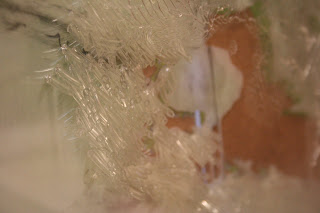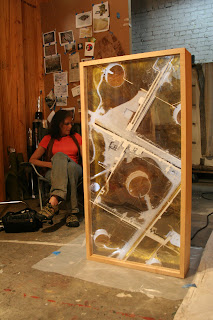Grace Grothus creates her synthetic landscapes from aerial reference and very diverse and unique materials layered into light boxes which are more than light boxes with spots that illuminate using circuit boards and other lighting sources I truly don't understand. We will be having her comment about them and the wide assortment of found objects, drawings and paintings in numerous layers that makeup her work in our documentary segment on Grace from the Creative-Native Project series on Oklahoma. Here are some closeups that I hope will give you a sense of her unique work. The detail is fabulous and hard to capture with out a direct experience of the human eye but we will try to give you a preview.
Here are effects she had created in her wide variety of media waiting to find the right piece and combination for her boxes.
Some closeups of segments of finished pieces....
It is hard to capture what
Grace is doing through stills with glare etc but this will give you a sense or a preconceived notion that will be expoded when you see them in the documentary. The film/ moving pictures should capture it well but this will give you a taste with production stills courtesy of Daniel Lay who assisted us on some of our locations. I hope these shots will leave you intrigued wanting to learn and see more.


The computer circuit boards that control some of the lighting which reacts to the viewer's movement.

It will be interesting for the viewer to see what their impressions are from these stills versus the film interview and viewing them live. But be baffled and ask questions in comments below and we will ask Grace to respond.
Turning the tradition of landscape art on its head, Grace Grothaus builds synthetic worlds illuminated from within. Explore her vision here.
To see how other artists have depicted city and landscape from
above click on the link above.

Unreal Scene (2008) by Liu Jianhua

San Francisco in Jell-o by Liz Hickok
San Francisco Cityscape with Cookware

On Gold Mountain: Sculptures from the Sierra by Zhang Wang
Egg City
eggscellent because it’s also the image of a RMB 50 bill! (Previously

Aerial landscape art includes paintings and other visual arts which depict or evoke the appearance of a landscape from a perspective above it—usually from a considerable distance—as it might be viewed from an aircraft or spacecraft. Sometimes the art is based not on direct observation but on aerial photography, or on mapscreated using satellite imagery. This kind of landscape art hardly existed before the 20th century; its modern development coincided with the advent of human transport which allowed for actual overhead views of large landscapes.
The earliest depictions of aerial landscapes are maps, or somewhat map-like artworks, which show a landscape from an imagined bird's-eye viewpoint. For example,Australian Aborigines, beginning in very ancient times, created "country" landscapes—aerial landscapes depicting their country—showing ancestral paths to watering holes and sacred sites. Centuries before air travel, Europeans developed maps of whole continents and even of the globe itself, all from an imagined aerial perspective, aided with mathematical calculations derived from surveys and knowledge of astronomical relationships.
There were other pre-20th century Western artworks sometimes depicting a single town or precinct in a manner that comes closer to real aerial landscape, showing a town or city more or less as it might look from directly overead. These map-like aerial townscapes often employed a kind of mixed perspective; while the overall view was quasi-aerial—showing the disposition of features arrayed as if seen from directly above—individual features of importance (such as churches or other major buildings) were pictured larger than scale, angled as they might look to someone standing on the ground. The map-like functional purpose of these pictures meant that such landmarks ought to be recognizable to a viewer, therefore, a realistic overhead view of the scene would defeat the purpose. The advent of balloon travel in the 19th century encouraged the development of more realistic aerial landscapes, as the first pioneering aviators begin to learn what landscapes and buildings really looked like when viewed from directly overhead.
Modernist abstraction and the aerial landscape
The artist Kazimir Malevich (1878-1935), who wrote extensively on the aesthetics and philosophy of modern art, identified the aerial landscape (especially the "bird's-eye view", looking straight down, as opposed to an oblique angle) as a genuinely new and radicalizing paradigm in the art of the twentieth century. In his view, air travel, and more specifically, aerial photography had created this broad change in consciousness. The Italian Futurists were similarly fascinated with aerial views of landscapes.
Unlike traditional landscapes, aerial landscapes often do not include any view of a horizon or sky, nor in such cases is there any recession of the view into an infinite distance. Additionally, there is a natural kinship between aerial landscape painting and abstract painting, not only because familiar objects are sometimes difficult to recognize when viewed aerially, but because there is no natural "up" or "down" orientation in thepainting. Often it seems that, as in a work of abstract expressionism, the painting might just as well be hung upside down or sideways. Furthermore, as in a Jackson Pollock or a Mark Tobey painting, such images often have an "all over" distribution of interest that defies any attempt to decide on a "correct" orientation or focal point.
In addition to Malevich, many other modern and contemporary artists have produced work inspired by aerial views of landscapes, including Georgia O'Keeffe, Susan Crile,Jane Frank, Richard Diebenkorn, Yvonne Jacquette, and Nancy Graves.
Special case: the aerial cloudscape
The aerial cloudscapes painted by Georgia O'Keeffe in the 1960s and 1970s are a special case. Many of them are not landscapes at all, since they don't show any land. They depict images of clouds viewed from above, suspended in blue sky, with the land below nowhere to be seen; it is the view of clouds regarded at a downward and sideways angle, as from the window of an airplane. These paintings depict a kind of "pseudo-horizon," formed not where land meets sky but where the suspended layer of clouds—a "pseudo-ground"—meets the empty upper sky. (See the external link below for an image of O'Keeffe's gigantic 1965 aerial cloudscape entitled "Sky Above Clouds IV", housed at the Art Institute of Chicago).
During this period, O'Keeffe also produced some aerial cloudscape paintings which qualify as true aerial landscape paintings because they include a view of the land below the clouds. An example is "It Was Blue and Green" (1960; see external link to image below). This painting shows a view of land seen from above through a thin layer of clouds, combining the aerial landscape and aerial cloudscape genres.
































No comments:
Post a Comment